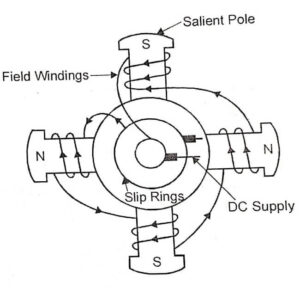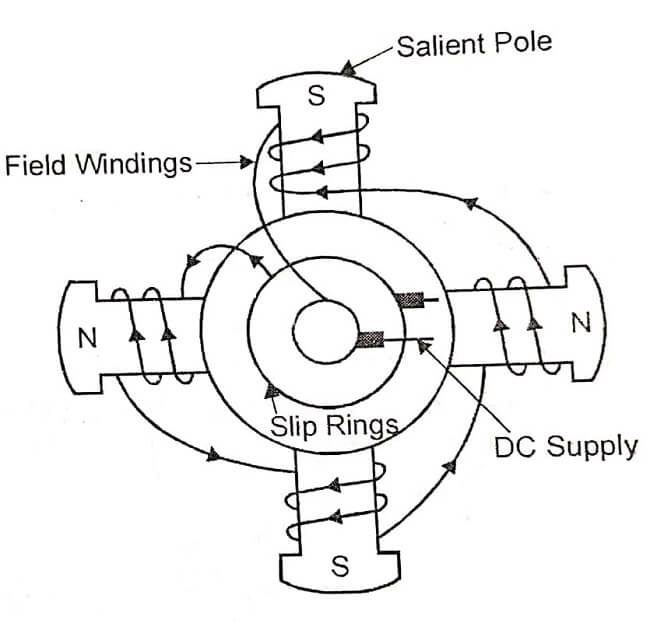The machine which produces 3 phase power from mechanical power is called an alternator or synchronous generator. An alternator works on the same fundamental principle of electromagnetic induction as a D.C generator, when the flux linking a conductor changes, an emf is induced in the conductor. Like a D.C generator, an alternator also has an armature winding and a field winding. But there is ne important difference between the two. In a d.c generator, the armature winding is placed on the rotor in order to provide a way of converting alternating voltage generated in the winding to a direct voltage at the terminals through the use of a rotating commutator.
The field poles are placed on the stationary part of the machine. In any alternator, standard construction consists of armature winding mounted on a stationary element called stator and field winding on a rotating element called rotor.
The frequency of output ac voltage of a synchronous generator is directly proportional to the rotor speed. To maintain constant frequency, the rotor must always move at synchronous speed.

Advantages of Stationary Armature
Synchronous machines have a rotating field-stationary armature construction. This construction offers the following advantages. a) Better insulation, b)Ease of current collection, c) Increased armature tooth strength, d) More rigid construction, e) Reduced armature leakage reactance, f) Lesser number of slip rings, g) Lesser rotor weight and inertia, h) Improved ventilation and heat dissipation.
Better Insulation
Modern synchronous machines have armature windings designed for 6.6kV or 11kV or 33kV. It is easier to insulate such a winding if it is on stator. Moreover the shaft of every machine is electrically earthed, through metallic bearings, to the stationary frame of the machine. It is easier to insulate a low voltage dc field winding on rotor than a rotating high voltage ac winding.
Ease of current collection
Modern synchronous generators are high current machines. The armature current of a 210 MVA, 11kV, 3-phase alternator is about 13kV. It is easier to collect such large currents if armature is stationary. The collection of such large currents through slip rings is very difficult.
Increased armature tooth strength
High armature currents require more copper and hence deep slots to accommodate the winding. When the slots of a stationary armature are made deeper, the teeth become wider and stronger. When the slots of a rotating armature are made deeper, the teeth become narrower and weaker. Strong teeth of the stationary armature construction are likely to be less damaged during fabrication and use.
More rigid construction
The high voltage, high current armature windings of modern 3-phase synchronous machines are rather complex and have many end connections and interconnections. Such windings are more rigid and secure when housed on stator.
Reduced armature leakage reactance
The stationary armature construction leads to lesser leakage flux and hence reduced armature leakage reactance. This leads to improved voltage regulation.
Lesser number of slip rings
If rotating armature construction is used, the machine would require 3 sliprings for the three phase. These sliprings would have to be properly insulated from shaft and also spaced suitably to avoid flashover. Rotating field structure requires only 2 sliprings insulated for low voltage dc (about 250V or so).
Lesser rotor weight and inertia
Because of low voltage field winding on rotor, the amount of copper and insulation required are less. Therefore rotor has lesser weight and inertia. Lesser weight of rotor leads to efficient high speed of operation and cheaper bearings. Due to lesser inertia the machine can be brought up to full speed, from rest, in a very short time.
Improved ventilation and heat dissipation
Most of the heat is generated in armature. When armature is on stator, the ventilation ducts and holes for cooling can be wider leading to better ventilation and heat dissipation.
| Read More Topics |
| Reactive power & voltage control |
| Magnetic confinement fusion |
| Series capacitor voltage |






